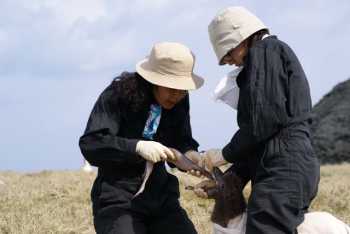Holly Jones (University of California, Santa Cruz) and Stephen Kress (National Audubon Society Seabird Restoration Program) have together reviewed active seabird restoration projects in the Journal of Wildlife Management.
The paper's abstract follows:
"Within the past several decades, seabird populations have been actively restored in locales where they were reduced or extirpated. Chick translocation, acoustic vocalization playbacks, and decoys are now used widely to lure breeding seabirds to restoration sites. In this first worldwide review of seabird restoration projects we evaluate the factors affecting project success or failure and recommend future directions for management. We identified 128 active restoration projects that were implemented to protect 47 seabird species in 100 locales spanning 14 countries since active restoration methods were pioneered in 1973. Active seabird restoration can achieve conservation goals for threatened and endangered species, and for species affected by anthropogenic impacts (e.g., oil spills, invasive species, fisheries). It also can be used to relocate populations from undesired breeding locales to more favorable locations, and to establish multiple breeding locations to reduce risks posed by catastrophic events. Active restoration can help to restore ecological processes, as large seabird colonies function to cycle marine nutrients to terrestrial ecosystems and create habitats for commensal species. Active restoration is especially appropriate where the original causes of decline are no longer working to suppress colony establishment and growth. Successful restoration efforts require careful planning and long-term commitments. We introduce the different forms of active seabird restoration techniques, review their utility for different seabird species, and use case studies to suggest how to optimize this technique to restore seabird species globally. Wildlife managers can use this review to guide their seabird restoration projects in the planning implementation, and monitoring stages; tailor their restoration to seabird-specific life histories; and identify areas for further research to improve restoration utility in the future."
So far, North Pacific albatrosses among ACAP-listed species have been the main target of restoration projects, with particularly exciting results coming in for the Short-tailed Albatross Phoebastria albatrus chicks that have been translocated from Torishima to Mukojima, with displaying juveniles now back on the island (click here). Technically, of course, as there is no evidence of prior breeding by Short-tails on Mukojima this is a translocation rather than a restoration project per se.

Feeding squid to a translocated Short-tailed Albatross chick on Mukojima Island
Photograph by Tomohiro Deguchi
See further information on North Pacific albatross translocation and restoration efforts at http://projectpuffin.org/nsarchive/ERUsrpUpdates2010a.pdf.
Success has also be been achieved with translocating ACAP-listed Black Petrels Procellaria parkinsoni (click here) and Fluttering Puffinus gavia (click here) and Hutton's P. huttoni (click here) Shearwaters in New Zealand.
Giving consideration to what other ACAP-listed species may be likely to benefit from active restoration/translocation projects would be an interesting exercise, but one for which feasibility would need to be factored in, given the remoteness of many of their breeding islands. Restoring breeding Tristan Albatrosses Diomedea dabbenena to the main island of Tristan da Cunha from where they have been extinct for around a century due to human exploitation and disturbance remains my personal favourite. One day...
Selected References:
Deguchi, T., Jacobs, J., Harada, T., Perriman, L., Watanabe, Y., Sato, F., Nakamura, N., Ozaki, K. & Balogh, G. 2011. Translocation and hand-rearing techniques for establishing a colony of threatened albatross. Bird Conservation International. doi: 10.1017/S0959270911000438.
Gummer, H. 2003. Chick translocation as a method of establishing new surface-nesting seabird colonies: a review. DOC Science Internal Series No. 150. Wellington: Department of Conservation. 40 pp.
Gummer, H. & Adams, L. 2010. Translocation Techniques for Fluttering Shearwaters (Puffinus gavia): Establishing a Colony on Mana Island, New Zealand. Wellington: Department of Conservation. 52 pp.
Jones, H.P. & Kress, S.W. 2012. A review of the world's active seabird restoration projects. Journal of Wildlife Management 76: 2-9. Click here to access the supplementary material: Appendix A. Details of reviewed seabird restoration projects.
Miskelly, C.M., Taylor, G.A., Gummer, H. & Williams, R. 2009. Translocations of eight species of burrow-nesting seabirds (genera Pterodroma, Pelecanoides, Pachyptila and Puffinus: Family Procellariidae). Biological Conservation 142: 1965-1980.
John Cooper, ACAP Information Officer, 28 January 2012

 English
English  Français
Français  Español
Español